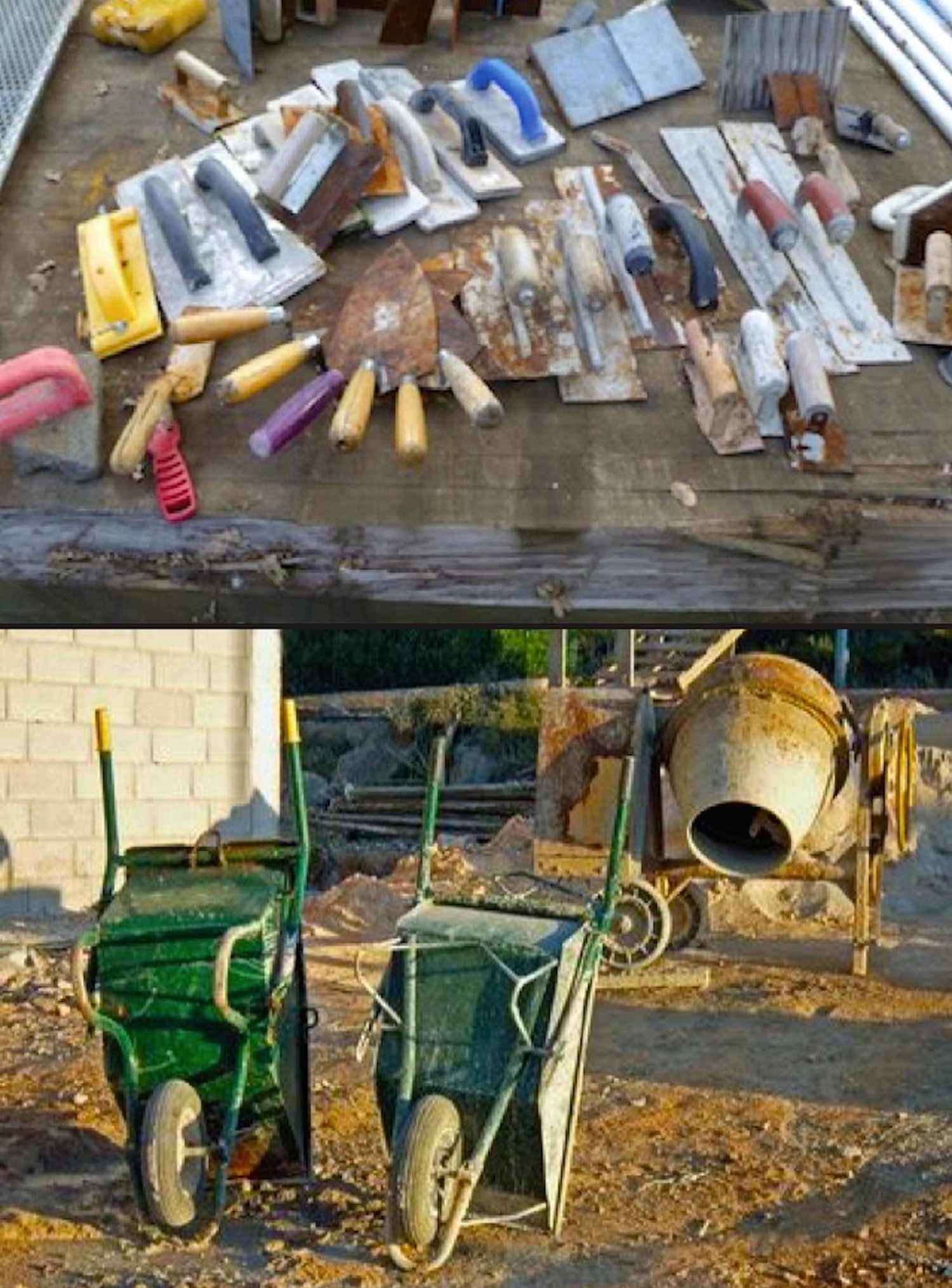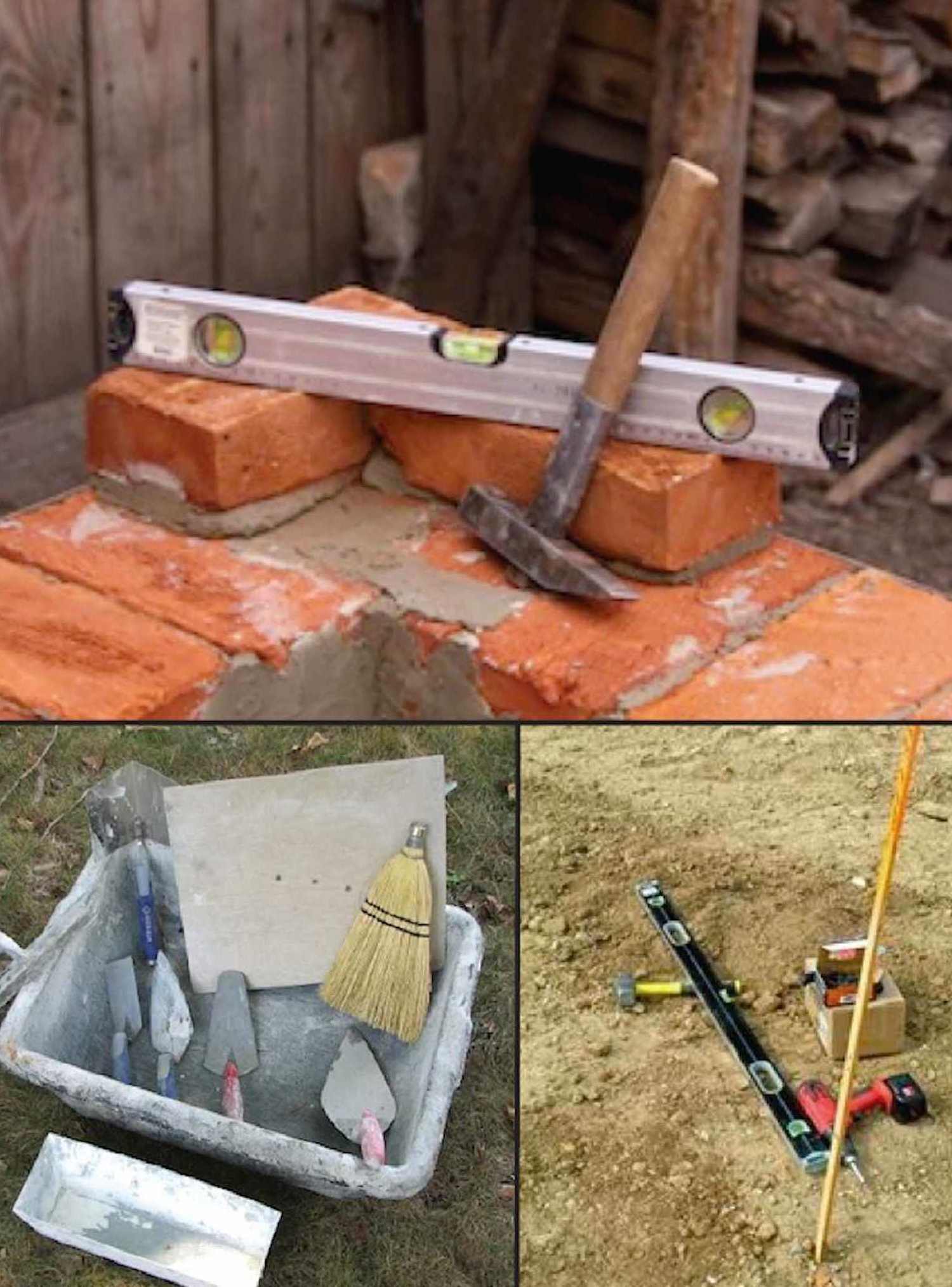Tony Jones


005: Construction Tool Sculptures
During the Walking series, I would often venture past numerous construction spaces. In my opinion, the beauty of these locations is all too often unnoticed or ignored. Based on these sentiments, I was inspired to begin a project that highlights the grandeur of constructed spaces. The first study in the series was titled Construction Tool Sculptures.
Construction Tool Sculptures contained an exacting specificity. In order to clearly explain this routine, I have provided the following statement:
I, Tony Jones, will build a series of works within construction spaces. The following conditions will guide my art making.
1. I will wander, by foot, in a square shaped pattern. I will take note of vacant construction sites and survey points of access.
2. Once all the workers have left, I will gain access to the site. I will walk the perimeter and search for tools that have been left out in the open or unsecured.
3. With the found tools, I will create physical patterns and sculptures within the site.
4. Once I have completed a series of tool sculptures, I will exit the construction premises before the workers return.
5. The construction worker, upon arriving the following day, should be able to notice that the sculpture is a work of creative expression.
Construction Tool Sculptures contained several fundamental themes that are relevant to my praxis.
First and foremost, it is a work completed outside of the confines of the museum/gallery setting. As an artist who views the museum as privileged and elite, the work underscored my commitment to making art without necessitating the exclusive wall space of entitled cultural gatekeepers. Furthermore, this theme was made more relevant due to the collaborative interaction between the unknown artist and the construction worker.
When speaking of the entitled gallery wall, we must take into account the laborer, the maker, the craftsman of these walls. I know of no gallery or museum wall that was constructed without the hands of an obscure and unnamed construction worker. If we are to appreciate the art that adorns the blank museum wall, should we not, at the same time, revere the meticulous craftsmanship of the construction artist?
There is a superb metaphor at play within this undertaking. Once humans decided to exhibit works on a wall (as opposed to the cave wall), a cyclical process was initiated. When the museum space became a reality, the artist developed an unrecognized interdependence with the construction worker. In order to display or sell a work of art, the artist necessitates the stability of the blank museum/gallery wall (or floor). Equally, the construction worker is employed and crafts the space due to a widespread societal demand for the artist. The worker builds, not for the need of blank walls, but due to a demand for museum/gallery centric exhibition. In essence, both laborer and artist act in symbiosis. One would not exist without the other.
This paradox is sadly ignored within established cultural circles. Art insiders may argue that the money generated by the art is the only factor when considering the need for a blank wall. However, they conveniently omit the involvement and artistry of the construction laborer. Although there is shrewd logic embedded within this argument, there remains a large discrepancy within this “trickle down” view of spatial and aesthetic economics. This type of stance glosses the argument with a “chicken or the egg” level of philosophical discourse. Ultimately, Construction Tool Sculptures was created to honor the contributions of the construction worker. Indeed, the craftsmanship of the wall must be valued and viewed with as much sincerity as the work that rests upon it.
Another theme that is requisite toConstruction Tool Sculptures is a commentary about the intended audience. Based on the specifics listed above, it is obvious that my sculptures are intended for the artistic satisfaction of the construction worker. Ideally, the worker, as opposed to the refined and polished art enthusiast, will be the only spectator with access to the sculptures. Accordingly, the tool sculptures needed to be configured in an expressive manner in order to reveal the artistry to its intended audience. As the creator of the work, I felt a sense of pride in building sculptures within the milieu of the construction space. This technique produced a mirroring effect in which the construction worker would view my creative output (tool sculptures) and I, in return, would view their creative output (the constructed buildings).
Indeed, this body of work demanded further practice and research. There is no mystery as to why this impulse continues in my next artistic exploration, titled Towers for a Construction Site Gallery.
During the Walking series, I would often venture past numerous construction spaces. In my opinion, the beauty of these locations is all too often unnoticed or ignored. Based on these sentiments, I was inspired to begin a project that highlights the grandeur of constructed spaces. The first study in the series was titled Construction Tool Sculptures.
Construction Tool Sculptures contained an exacting specificity. In order to clearly explain this routine, I have provided the following statement:
I, Tony Jones, will build a series of works within construction spaces. The following conditions will guide my art making.
1. I will wander, by foot, in a square shaped pattern. I will take note of vacant construction sites and survey points of access.
2. Once all the workers have left, I will gain access to the site. I will walk the perimeter and search for tools that have been left out in the open or unsecured.
3. With the found tools, I will create physical patterns and sculptures within the site.
4. Once I have completed a series of tool sculptures, I will exit the construction premises before the workers return.
5. The construction worker, upon arriving the following day, should be able to notice that the sculpture is a work of creative expression.
Construction Tool Sculptures contained several fundamental themes that are relevant to my praxis.
First and foremost, it is a work completed outside of the confines of the museum/gallery setting. As an artist who views the museum as privileged and elite, the work underscored my commitment to making art without necessitating the exclusive wall space of entitled cultural gatekeepers. Furthermore, this theme was made more relevant due to the collaborative interaction between the unknown artist and the construction worker.
When speaking of the entitled gallery wall, we must take into account the laborer, the maker, the craftsman of these walls. I know of no gallery or museum wall that was constructed without the hands of an obscure and unnamed construction worker. If we are to appreciate the art that adorns the blank museum wall, should we not, at the same time, revere the meticulous craftsmanship of the construction artist?
There is a superb metaphor at play within this undertaking. Once humans decided to exhibit works on a wall (as opposed to the cave wall), a cyclical process was initiated. When the museum space became a reality, the artist developed an unrecognized interdependence with the construction worker. In order to display or sell a work of art, the artist necessitates the stability of the blank museum/gallery wall (or floor). Equally, the construction worker is employed and crafts the space due to a widespread societal demand for the artist. The worker builds, not for the need of blank walls, but due to a demand for museum/gallery centric exhibition. In essence, both laborer and artist act in symbiosis. One would not exist without the other.
This paradox is sadly ignored within established cultural circles. Art insiders may argue that the money generated by the art is the only factor when considering the need for a blank wall. However, they conveniently omit the involvement and artistry of the construction laborer. Although there is shrewd logic embedded within this argument, there remains a large discrepancy within this “trickle down” view of spatial and aesthetic economics. This type of stance glosses the argument with a “chicken or the egg” level of philosophical discourse. Ultimately, Construction Tool Sculptures was created to honor the contributions of the construction worker. Indeed, the craftsmanship of the wall must be valued and viewed with as much sincerity as the work that rests upon it.
Another theme that is requisite toConstruction Tool Sculptures is a commentary about the intended audience. Based on the specifics listed above, it is obvious that my sculptures are intended for the artistic satisfaction of the construction worker. Ideally, the worker, as opposed to the refined and polished art enthusiast, will be the only spectator with access to the sculptures. Accordingly, the tool sculptures needed to be configured in an expressive manner in order to reveal the artistry to its intended audience. As the creator of the work, I felt a sense of pride in building sculptures within the milieu of the construction space. This technique produced a mirroring effect in which the construction worker would view my creative output (tool sculptures) and I, in return, would view their creative output (the constructed buildings).
Indeed, this body of work demanded further practice and research. There is no mystery as to why this impulse continues in my next artistic exploration, titled Towers for a Construction Site Gallery.